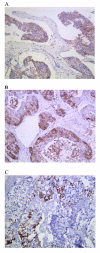Solitary adrenal metastasis from invasive ductal breast cancer: an uncommon finding
- PMID: 20105336
- PMCID: PMC2824745
- DOI: 10.1186/1477-7819-8-7
Solitary adrenal metastasis from invasive ductal breast cancer: an uncommon finding
Abstract
Background: Invasive ductal carcinoma (IDC) of the breast usually metastasizes to the lungs, liver, bones and brain. Solitary adrenal metastasis is extremely rare. Due to the rarity of this condition, the optimal treatment is unclear. We report the first case of IDC of the breast metastasizing solely to the adrenal gland after a modified radical mastectomy but having a long-term disease-free survival while treated merely by a left adrenalectomy.
Case presentation: A 64-year-old woman was found a left adrenal mass on a follow-up visit two years after taking a right modified radical mastectomy for the breast cancer. She was subsequently given a left adrenalectomy. Postoperative histopathology findings were compatible with invasive ductal carcinoma (IDC) of the breast. Due to the patient's refusal, no further treatments were offered after the adrenalectomy. The patient now is still alive and has no sign of relapse. Survival time after taking the right modified radical mastectomy and the left adrenalectomy is more than five years and three years, respectively.
Conclusion: This is the first case of a patient with solitary, metachronous adrenal metastasis from IDC of the breast to be reported. For patients in this condition, complete removal of metastasized organ may translate into survival benefit.
Figures



Similar articles
-
Solitary Adrenal Metastases from Breast Invasive Ductal Carcinoma.Chirurgia (Bucur). 2017 Jul-Aug;112(4):473-476. doi: 10.21614/chirurgia.112.4.473. Chirurgia (Bucur). 2017. PMID: 28862125
-
[A Rare Case of Adrenal Metastasis Diagnosed before Discovery of Invasive Ductal Breast Cancer which was Confirmed to Be the Primary Site].Hinyokika Kiyo. 2022 Jul;68(7):239-243. doi: 10.14989/ActaUrolJap_68_7_239. Hinyokika Kiyo. 2022. PMID: 35924707 Japanese.
-
Bilateral synchronous adrenal metastasis of invasive ductal carcinoma treated with multimodality therapy including adrenalectomy and oophorectomy.J Oncol Pharm Pract. 2016 Feb;22(1):157-60. doi: 10.1177/1078155214551314. Epub 2014 Sep 16. J Oncol Pharm Pract. 2016. PMID: 25227232
-
Metastasis of breast cancer to renal cancer: report of a rare case.Int J Clin Exp Pathol. 2015 Nov 1;8(11):15417-21. eCollection 2015. Int J Clin Exp Pathol. 2015. PMID: 26823905 Free PMC article. Review.
-
The role of surgery in renal cell carcinoma with solitary metachronous metastasis to contralateral adrenal gland.Anticancer Res. 1999 Nov-Dec;19(6C):5575-6. Anticancer Res. 1999. PMID: 10697620 Review.
Cited by
-
Surgical management of metastatic adrenal tumors: Decision-making factors in imaging.Oncol Lett. 2010 Nov;1(6):967-971. doi: 10.3892/ol.2010.183. Epub 2010 Sep 23. Oncol Lett. 2010. PMID: 22870096 Free PMC article.
-
Adrenal crisis in metastatic breast cancer.BMJ Case Rep. 2017 Jul 6;2017:bcr2017220284. doi: 10.1136/bcr-2017-220284. BMJ Case Rep. 2017. PMID: 28687693 Free PMC article.
-
Long-Term Survival of Metachronous Isolated Adrenal Metastasis in Luminal Breast Cancer: A Case Report and Literature Review.Cureus. 2025 Jan 28;17(1):e78142. doi: 10.7759/cureus.78142. eCollection 2025 Jan. Cureus. 2025. PMID: 40018471 Free PMC article.
-
Bilateral Infiltrating Ductal Carcinoma With Adrenal Metastasis: A Rare Case Report.Cureus. 2024 Jul 29;16(7):e65635. doi: 10.7759/cureus.65635. eCollection 2024 Jul. Cureus. 2024. PMID: 39205706 Free PMC article.
-
Adrenal Gland Metastasis of Breast Invasive Mucinous Carcinoma: A Rare Case Report and Review of Literature.Case Rep Oncol. 2022 Jun 23;15(2):636-641. doi: 10.1159/000525214. eCollection 2022 May-Aug. Case Rep Oncol. 2022. PMID: 35949905 Free PMC article.
References
-
- Borst MJ, Ingold JA. Metastatic patterns of invasive lobular versus invasive ductal carcinoma of the breast. Surgery. 1993;114:637–641. - PubMed
-
- Bumpers HL, Hassett JM, Penetrante RB, Hoover EL, Holyoke ED. Endocrine organ metastases in subjects with lobular carcinoma of the breast. Arch Surg. 1993;128:1344–1347. - PubMed
Publication types
MeSH terms
LinkOut - more resources
Full Text Sources
Medical

